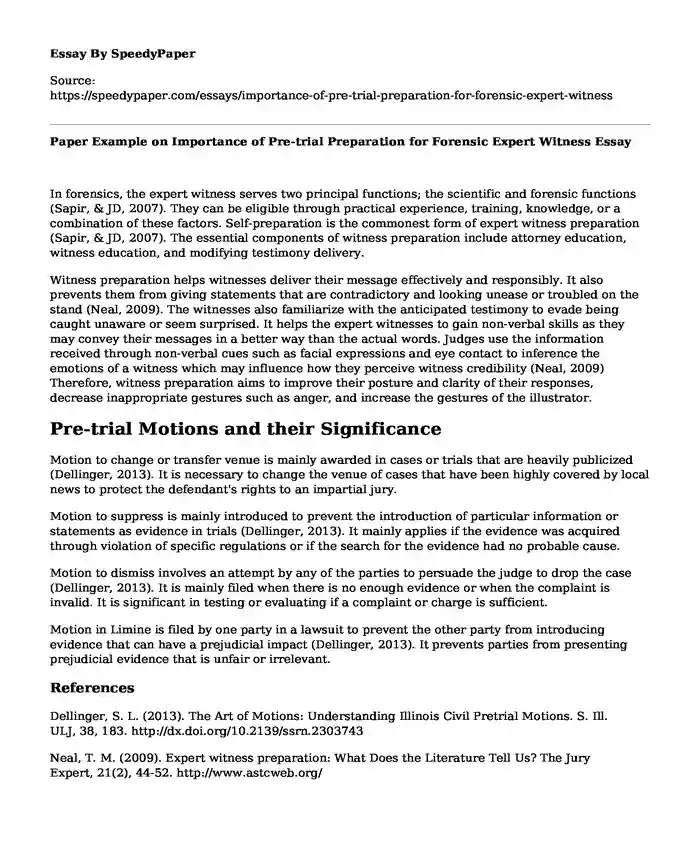
| Essay type: | Persuasive essays |
| Categories: | Learning Criminal law Forensic science Criminal justice |
| Pages: | 2 |
| Wordcount: | 436 words |
In forensics, the expert witness serves two principal functions; the scientific and forensic functions (Sapir, & JD, 2007). They can be eligible through practical experience, training, knowledge, or a combination of these factors. Self-preparation is the commonest form of expert witness preparation (Sapir, & JD, 2007). The essential components of witness preparation include attorney education, witness education, and modifying testimony delivery.
Witness preparation helps witnesses deliver their message effectively and responsibly. It also prevents them from giving statements that are contradictory and looking unease or troubled on the stand (Neal, 2009). The witnesses also familiarize with the anticipated testimony to evade being caught unaware or seem surprised. It helps the expert witnesses to gain non-verbal skills as they may convey their messages in a better way than the actual words. Judges use the information received through non-verbal cues such as facial expressions and eye contact to inference the emotions of a witness which may influence how they perceive witness credibility (Neal, 2009) Therefore, witness preparation aims to improve their posture and clarity of their responses, decrease inappropriate gestures such as anger, and increase the gestures of the illustrator.
Pre-trial Motions and their Significance
Motion to change or transfer venue is mainly awarded in cases or trials that are heavily publicized (Dellinger, 2013). It is necessary to change the venue of cases that have been highly covered by local news to protect the defendant's rights to an impartial jury.
Motion to suppress is mainly introduced to prevent the introduction of particular information or statements as evidence in trials (Dellinger, 2013). It mainly applies if the evidence was acquired through violation of specific regulations or if the search for the evidence had no probable cause.
Motion to dismiss involves an attempt by any of the parties to persuade the judge to drop the case (Dellinger, 2013). It is mainly filed when there is no enough evidence or when the complaint is invalid. It is significant in testing or evaluating if a complaint or charge is sufficient.
Motion in Limine is filed by one party in a lawsuit to prevent the other party from introducing evidence that can have a prejudicial impact (Dellinger, 2013). It prevents parties from presenting prejudicial evidence that is unfair or irrelevant.
References
Dellinger, S. L. (2013). The Art of Motions: Understanding Illinois Civil Pretrial Motions. S. Ill. ULJ, 38, 183. http://dx.doi.org/10.2139/ssrn.2303743
Neal, T. M. (2009). Expert witness preparation: What Does the Literature Tell Us? The Jury Expert, 21(2), 44-52. http://www.astcweb.org/
Sapir, G., & JD, M. (2007). Qualifying the Expert Witness: A Practical Voir Dire. Forensic Magazine, 4(1), 30. https://www.ncjrs.gov/App/Publications/abstract.aspx?ID=239149
Cite this page
Paper Example on Importance of Pre-trial Preparation for Forensic Expert Witness. (2023, Nov 15). Retrieved from https://speedypaper.com/essays/importance-of-pre-trial-preparation-for-forensic-expert-witness
Request Removal
If you are the original author of this essay and no longer wish to have it published on the SpeedyPaper website, please click below to request its removal:
- Dark Matter Essay Exam[ple
- Statistical Research Proposal - Free Paper to Meet Your Purposes
- Free Essay Example on Juveniles Joining Gangs in America
- Teaching Essay Sample: Thematic Unit Lesson Plan
- University Entrance Personal Statement Essay Sample
- Free Paper Example on Cholesterol
- PWI: The Meaning of Abbreviation and Its Impact on Society. Essay Sample
Popular categories




